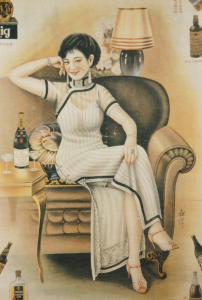
The image above is a calendar poster that is advertising Grande, Price, and Co. from 1934. This calendar poster shows a middle-aged woman sitting on a couch dressed in a white, sheer qipao. The woman also has a smile on her face, something rare during this time period especially when the woman would have to stay in a pose for a long period of time. The woman also is covered in fancy jewelry, from her diamond earrings to her bracelets and rings. Perhaps this represents high class.
introduce a thesis statement righter after the brief image description, which will lead both the writer and the reader for the reading of this poster
Focusing primarily on the nature of the specific qipao in this photo, you can see many features that stand out. To begin, you can see that the slit is very high, displaying a much more sexualized form of the qipao. This high slit shows much more skin and contradicts the usual lady-like nature of this Chinese dress.
Another feature of the qipao that contradicts its usual classy nature is it’s sheer quality. Because of this, the undergarments are all visible. This shows a very provocative form of the qipao that serves the purpose of sex.
The last feature that stands out is the woman’s pose. The female’s crossed legs and arm on her head looks like she is waiting for a sexual partner. As we learned in class, it is “improper for a lady to sit with her legs crossed” according to a 1930 article in the magazine, The Modern Lady. When learning about the history of the qipao in class, we were shown images of woman with emotionless faces in simple stances. For those examples, the qipao was the primary focus of the photos. However, in this image, the qipao is not the focal point and is just helping contribute to the sexualized message of the advertisement.
Digging deeper into this image, we can see how the female body is clearly being used to sell the product being sold, in this case alcohol. The sexually inviting pose, as discussed before, as well as the two empty glasses beside the woman further indicates the sexualized intention of this poster.
this idea could serve as the thesis: sexualized female body and sold commodities
This poster sparked a lot of thought when looking at how it connects to our society today. Even though this calendar poster was from 1934 in China, we still are using women’s bodies to sell products. How can our society shift from relying on female bodies to sell a company’s product? Furthermore, how can we go about doing this without tainting such a national figure as the qipao?
the post could center on the argument of “sexualized female body and advertisement of commodities” and find visual evidence to support it
